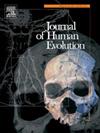Facial morphologies of Middle Pleistocene Europe: Morphological mosaicism and the evolution of Homo neanderthalensis
IF 3.1
1区 地球科学
Q1 ANTHROPOLOGY
引用次数: 0
Abstract
The phylogeny of the Middle Pleistocene hominins is a matter of intense scientific debate. Important phylogenetic and taxonomic uncertainties remain, not least due to conflicting results of phylogenetic analyses when methodologies or morphological focus differ. Geography has been proposed to play a key role in Middle Pleistocene hominin diversity, with a European group potentially ancestral to Neanderthals (Homo neanderthalensis) and an African group possibly ancestral to Homo sapiens, but the evidence is equivocal. In this study, we explore the connection between geography and facial morphology in Middle Pleistocene hominins with a particular emphasis on the potential Neanderthal affinities of the European group. Furthermore, to assess the impact of methodology on the results, we use a multimethod approach in which morphological affinities in both facial shape and discrete facial traits are assessed on a dataset consisting of 38 fossil and 20 recent hominin skulls divided into five groups (European and non-European Middle Pleistocene hominins, H. sapiens, H. neanderthalensis, and Homo erectus/Homo ergaster). Two main conclusions emerge from these analyses. First, methodological approach has a marked impact on the recorded pattern of morphological affinity, which may explain result discrepancies among previous studies. Second, this disparity may be caused by morphological mosaicism and polymorphism in the facial region of Middle Pleistocene hominins. The results provide some support for a closer connection between European Middle Pleistocene hominins and Neanderthals in terms of discrete facial traits, but not in overall facial shape, raising questions about the process of evolution of the Neanderthal facial phenotype. As a consequence of these results, we argue that greater attention needs to be paid to clarifying the broader evolutionary processes guiding hominin evolution during this period.
欧洲中更新世的面部形态:形态镶嵌和尼安德特人的进化
中更新世人类的系统发育是一个激烈的科学争论的问题。重要的系统发育和分类学的不确定性仍然存在,尤其是由于当方法或形态学焦点不同时,系统发育分析的结果相互矛盾。地理被认为在中更新世人类多样性中起着关键作用,一个欧洲群体可能是尼安德特人(穴居人)的祖先,一个非洲群体可能是智人的祖先,但证据是模棱两可的。在这项研究中,我们探索了地理与中更新世人类面部形态之间的联系,特别强调了欧洲群体潜在的尼安德特人亲缘关系。此外,为了评估方法对结果的影响,我们使用了一种多方法方法,在一个数据集上评估了面部形状和离散面部特征的形态学亲和性,该数据集由38个化石和20个新近的人类头骨组成,分为5个群体(欧洲和非欧洲中更新世人类、智人、尼安德特人、直立人/直立人)。这些分析得出了两个主要结论。首先,方法方法对形态学亲和模式的记录有显著影响,这可能解释了以往研究结果的差异。第二,这种差异可能是由中更新世古人类面部区域的形态嵌合和多态性造成的。这一结果为欧洲中更新世人族与尼安德特人在离散的面部特征上有更密切的联系提供了一些支持,但在整体面部形状上却没有,这就提出了关于尼安德特人面部表型进化过程的问题。由于这些结果,我们认为需要更多的注意力来澄清在这一时期指导人类进化的更广泛的进化过程。
本文章由计算机程序翻译,如有差异,请以英文原文为准。
求助全文
约1分钟内获得全文
求助全文
来源期刊

Journal of Human Evolution
生物-进化生物学
CiteScore
6.30
自引率
15.60%
发文量
104
审稿时长
3 months
期刊介绍:
The Journal of Human Evolution concentrates on publishing the highest quality papers covering all aspects of human evolution. The central focus is aimed jointly at paleoanthropological work, covering human and primate fossils, and at comparative studies of living species, including both morphological and molecular evidence. These include descriptions of new discoveries, interpretative analyses of new and previously described material, and assessments of the phylogeny and paleobiology of primate species. Submissions should address issues and questions of broad interest in paleoanthropology.
 求助内容:
求助内容: 应助结果提醒方式:
应助结果提醒方式:


